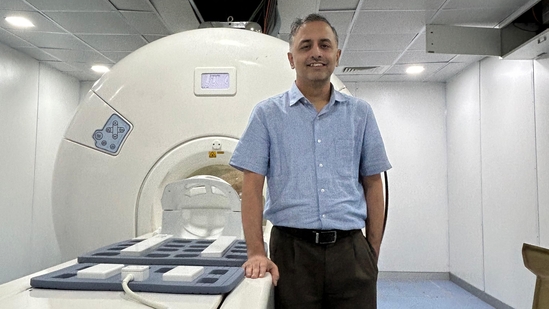Yes We Scan: MRI machines are now being built in India. See how they stack up
Smarter tech, smaller magnets, cheaper coolants: Entrepreneurs, innovators are building MRI machines more cheaply here at home. But that is just the first step.
There are less than 5,000 MRI machines in India, according to data released by the union ministry of science and technology in August. That’s about 3.5 machines per million of the population.

How low is this? In the US and Japan, which stand at the other end of this spectrum, there are 30 to 50 MRI machines per million people, as of 2021. (The cost of access, of course, is an issue of its own, across the board.)
One factor keeping the number down in India, is cost. An MRI machine costs between ₹5 crore and ₹9 crore, after import duties.
“The market is dominated by a handful of companies, including Philips, Siemens, GE, Toshiba and Hitachi,” says Arjun Arunachalam, 44, a rare home-grown entrepreneur in this space.
Arunachalam has a PhD in electrical engineering from the University of Wisconsin, where he specialised in the field of magnetic resonance imaging, before working for three years at the GE Global Research Center in New York State.
He then returned home to Bengaluru and founded Voxelgrids Innovations, in 2017.
In 2018, Voxelgrids installed the first Indian-made MRI prototype at Bengaluru’s Sri Sathya Sai Institute of Higher Medical Sciences, for beta testing.
The machine took about $1.5 million ( ₹12.4 crore) to develop, funded partly by not-for-profit platform Social Alpha, supported by Tata Trusts, with assistance from the union ministry of science and technology’s BIRAC (Biotechnology Industry Research Assistance Council).
Once they begin commercial rollout, Arunachalam estimates that his machines will cost at least 40% less than the imported ones.
The even better news is that Voxelgrids isn’t the only Indian company innovating in this space.

In September 2022, a team of scientists from the Inter-University Accelerator Centre (IUAC) in New Delhi, led by Avinash Chandra Pandey, successfully developed India’s first superconducting magnet of the field strength and size needed for an MRI machine.
Work on the IUAC project began in 2015, supported by the union ministry of electronics and information technology’s autonomous R&D institute, SAMEER (Society for Applied Microwave Electronics Engineering and Research).
Now, scientists at the Centres for Development of Advanced Computing (C-DAC) in Pune and Thiruvananthapuram are working to build the required software to go with the magnet and its cooling and radio-frequency systems, to complete the first magnetic system for an Indian-made MRI machine.
“The IUAC project is very interesting because they have attempted to create Indian solutions to every step in the MR imaging chain,” says Vikas Gulani, Fred Jenner Hodges professor and chair at the department of radiology at the University of Michigan. “They started with a GE magnet and have stepwise replaced every piece of it with an Indian-engineered solution. They have also attempted to create unique modern solutions to engineering problems that they feel may not be optimally answered in the current design of magnets. If successful, I understand that they want to create spin-off companies, an entire ecosystem of them, that build everything in the magnet in India. It is very bold and could spark a full industry.”
One drawback: The IUAC machine, like most around the world, uses vast quantities of liquid helium in the cooling system. This poses a problem because liquid helium is exorbitant, India does not have its own reserves, and prices are rising amid dips in supply globally.
Here, Voxelgrids presents a workaround. Its MRI scanner bypasses liquid helium, through innovative tweaks to the traditional form. It is built to use a smaller magnet, and a cryogenic pump that can be fuelled by liquid helium or the far-more-easily-available liquid nitrogen, to keep the innards cool, lower resistance and achieve the required magnetic field.
Arunachalam says the machine makes up for its 10% smaller magnet with sophisticated data-collection and deep-learning software.
Voxelgrids collaborated with the Indian Institute of Science (IISc) in Bengaluru for its cryogenic system, and with the Intel Startup Program, which helped secure integrated chips for the device. “This combination of next-generation hardware with software has successfully introduced a highly disruptive product in the diagnostic imaging space,” Dr Jitendra Singh, union minister of state for science and technology, said, speaking at a launch event for the Voxelgrids scanner, held in Delhi in August.
Also in August, Arunachalam and his team published an invited paper in the journal NMR in Biomedicine, and gave a plenary lecture at International Society for Magnetic Resonance in Medicine, on the Voxelgrids MRI scanner. By then, the design had received the go-ahead from the union government. The machine installed at the Sri Sathya Sai institute will become functional by the end of the year (tweaks are currently being made as per the final mass-manufacturing licence).
The machines are a first step that could lead to many more. “These technologies could cause clinical innovation as vast new patient groups are imaged,” Gulani says. “There may be huge AI-driven leaps needed in interpretive technology. Imagine trying to provide reads on these scans. We don’t have enough doctors! We will need to train new technologists, an expanded new workforce.”
There’s a lot to be done, once the switch is turned on.








